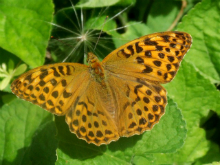
Locally common


Distribution and Status
The Silver-washed Fritillary is fairly widespread in the wooded areas in the two counties. In the 1980s few colonies were present, mainly in central Hertfordshire and the Bricket Wood complex. By the start of this century, the butterfly had virtually disappeared from our branch area. However, during the early 2000s expansion in range had begun from the south-west and spread into Hertfordshire with the largest impact in the hot summer of 2006. The last few years have seen more colonies found in Middlesex
Habitat Requirements
Favours woodland clearings and rides with males more likely to be seen in the more open areas. Females on the other hand prefer shadier places to lay her eggs into crevices on a tree trunk, usually of oak, close to where there are clumps of Common Dog-violet
Larval Foodplants
Common Dog-violet Viola riviniana
Adult Food Sources
Bramble Rubus fruticosis, Buddleia Buddleja davidii, Heather Calluna vulgaris
Behaviour/Observation notes
Both sexes are usually very active with their graceful and gliding flight and are easy to detect. Males establish territories in woodland clearings whereas females are often seen fluttering in shadier areas near violet flowers close to oak trees

Life History
The Silver-washed Fritillary is a single-brooded butterfly emerging from late June until the end of August. Males emerge about two weeks earlier than the females. Females lay eggs in the crevices of a tree bark often facing north 1 to 2 metres above ground. The eggs hatch out in August. The larva eats the eggshell then spends the winter on the tree trunk. In the spring, the larva descends the tree trunk and searches for the foodplants on which to feed. Pupae lay suspended under a leaf or on a twig
Further information
Photo gallery
Branch Annual Report (2022)
UK distribution map
Full list of larval hostplants (Nymphalidae)
Stevenage butterflies - additional notes